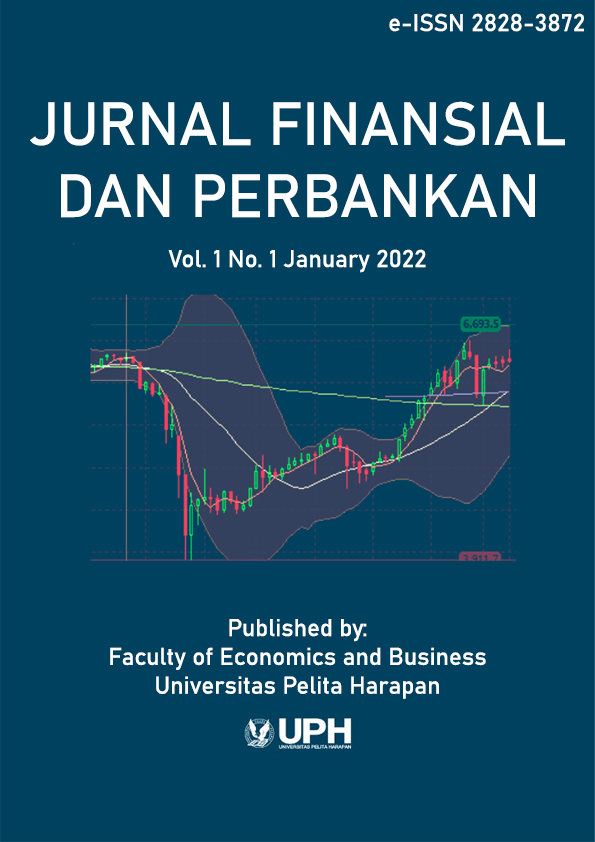Stock Market Response to Unexpected Dividend Changed in Indonesia
DOI:
https://doi.org/10.19166/jfp.v1i1.3981Ключевые слова:
bond rating, dividend payment, firm valueАннотация
The writer finds that bond rating and dividend can change the firm value. Specifically, when a firm with bond rating has an increase in their dividend, their firm value will decrease. While when the firm without bond rating has an increase in their dividend, their firm value will also increase. It is very strange as to why the firm with bond rating can decrease in their firm value when their dividend is increasing. In this research, the writer explains this phenomena. Besides explaining this phenomena, the writer also can prove that bond rating and dividend is really critical in determining the firm value by conducting two researches (firm with and without bond rating) which other researchers have not done yet. The data that will be using is the firms with and without bond rating in Indonesia between 2007 and 2016.
Библиографические ссылки
Bhattacharya, S. (1979). Imperfect information, dividend policy, and “the bird in the hand” fallacy. The Bell Journal of Economics, 10(1), 259-270. https://doi.org/10.2307/3003330
Daniels, K., Tsai, S. S., & Cheng F. L. (1997). The information content of dividend hypothesis: A permanent income approach. International Review of Economics & Finance, 6(1), 77-86. https://doi.org/10.1016/S1059-0560(97)90016-2
Dhillon, U. S., & Johnson, H. (1994). The effect of dividend changes on stock and bond prices. The Journal of Finances, 49(1), 281-289. https://doi.org/10.1111/j.1540-6261.1994.tb04430.x
Estiyanti, N. M., & Yasa, G. W. (2012). Pengaruh faktor keuangan dan non keuangan pada peringkat obligasi di Bursa Efek Indonesia. Simposium Nasional Akuntansi XV Banjarmasin.
Ghosh, C., & Woolridge, J. R. (1988). An analysis of shareholder reaction to dividend cuts and omissions. The Journal of Financial Research, 11(4), 281-294. https://doi.org/10.1111/j.1475-6803.1988.tb00089.x
Handjinicolaou, G. & Kalay, A. (1984). Wealth redistributions or changes in firm value: An analysis of returns to bondholders and stockholders around dividend announcements. Journal of Financial Economics, 13(1), 35-63. https://doi.org/10.1016/0304-405X(84)90031-X
Holthausen, R. W., & Leftwich, R. W. (1986). The effect of bond rating changes on common stock prices. Journal of Financial Economics, 17(1), 57-89. https://doi.org/10.1016/0304-405X(86)90006-1
Jensen, M. C. (1986). Agency costs of free cash flow, corporate finance, and takeovers. The American Economic Review, 76(2), 323-329. http://www.jstor.org/stable/1818789
Jensen, M. C., & Meckling, W. H. (1976). Theory of the firm: Managerial behavior, agency costs and ownership structure. Journal of Financial Economics, 3(4), 305-360. https://doi.org/10.1016/0304-405X(76)90026-X
Jorion, P., & Zhang, G. (2007). Good and bad credit contagion: Evidence from credit default swaps. Journal of Financial Economics, 84(3), 860-883. https://doi.org/10.1016/j.jfineco.2006.06.001
Kalay, A. (1980). Signaling, information content, and the reluctance to cut dividends. The Journal of Financial and Quantitative Analysis, 15(4), 855-869. https://doi.org/10.2307/2330564
Liu, C., & Chen, A. -S. (2015). Do firms use dividend changes to signal future profitability? A simultaneous equation analysis. International Review of Financial Analysis, 37, 194-207. https://doi.org/10.1016/j.irfa.2014.12.001
Merton, R. C. (1974). On the pricing of corporate debt: The risk structure of interest rates. The Journal of Finance, 29(2), 449-470. https://doi.org/10.2307/2978814
Miller, M. H., & Modigliani, F. (1961). Dividend policy, growth, and the valuation of shares. The Journal of Business, 34(4), 411-433. https://doi.org/10.1086/294442
Miller, M. H., & Rock, K. (1985). Dividend policy under asymmetric information. The Journal of Finance, 40(4), 1031-1051. https://doi.org/10.1111/j.1540-6261.1985.tb02362.x
Ross, S. A. (1977). The determination of financial structure: The incentive-signalling approach. The Bell Journal of Economics, 8(1), 23. https://doi.org/10.2307/3003485
Tsai, H. -J., & Wu, Y. (2014). Bond and stock market response to unexpected dividend changes. Journal of Empirical Finance, 30(C), 1-15. https://doi.org/10.1016/j.jempfin.2014.11.001
Wendy, & Sianturi, R. N. (2017). Bond ratings dan antesedennya: Studi empiris di Bursa Efek Indonesia. Jurnal Ekonomi Bisnis dan Kewirausahaan, 6(1), 59-70. https://doi.org/10.26418/jebik.v6i1.20727
Woolridge, J. R. (1983). Dividend changes and security prices. The Journal of Finances, 38(5), 1607-1615. https://doi.org/10.1111/j.1540-6261.1983.tb03844.x
Zaima, J. K., & McCarthy, J. (1988). The impact of bond rating changes on common stocks and bonds: Tests of the wealth redistribution hypothesis. The Financial Review, 23(4), 483-498. https://doi.org/10.1111/j.1540-6288.1988.tb01283.x
Zhao, R. (2007). Signaling or wealth transfer: Evidence from the response of corporate bonds to payout changes. SSRN. https://dx.doi.org/10.2139/ssrn.1912390
Загрузки
Опубликован
Выпуск
Раздел
Лицензия
Authors who publish with this journal agree to the following terms:
1) Authors retain copyright and grant the journal right of first publication with the work simultaneously licensed under a Creative Commons Attribution License (CC-BY-SA 4.0) that allows others to share the work with an acknowledgement of the work's authorship and initial publication in this journal.
2) Authors are able to enter into separate, additional contractual arrangements for the non-exclusive distribution of the journal's published version of the work (e.g., post it to an institutional repository or publish it in a book), with an acknowledgement of its initial publication in this journal.
3) Authors are permitted and encouraged to post their work online (e.g., in institutional repositories or on their website). The final published PDF should be used and bibliographic details that credit the publication in this journal should be included.

